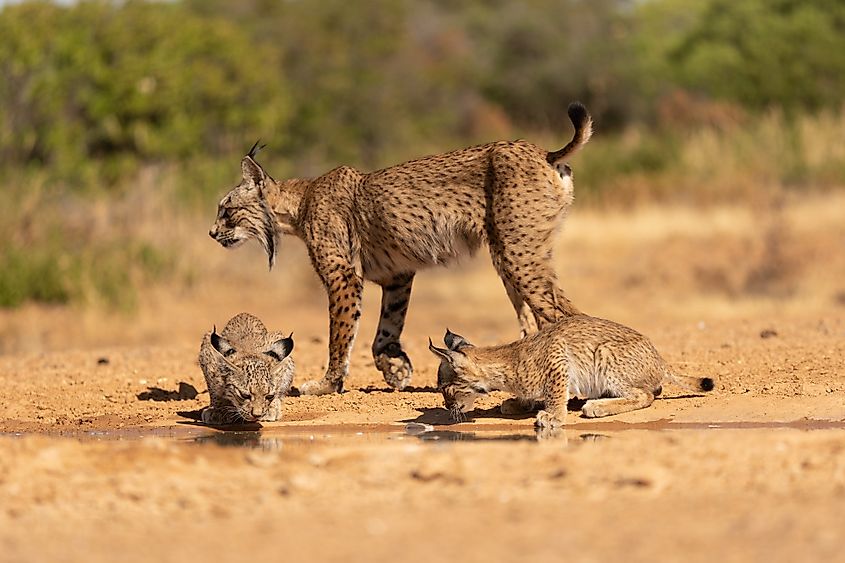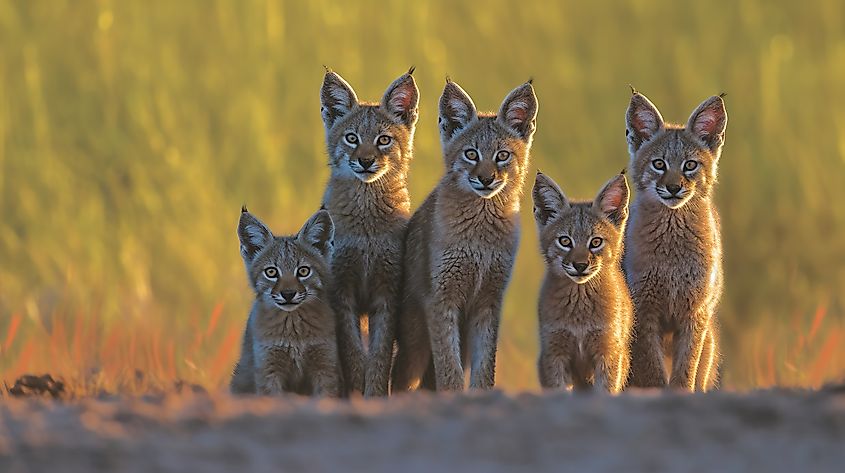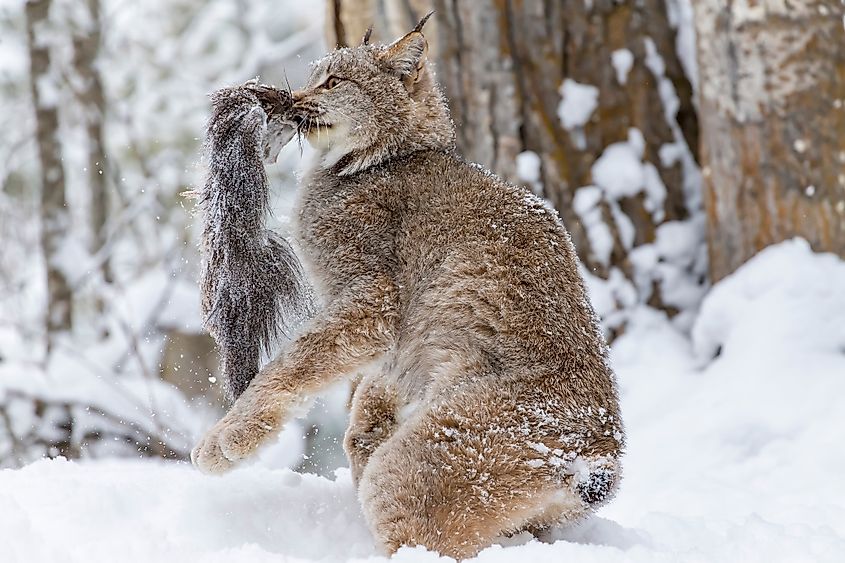
Discover The Lynx
Lynx is both the scientific and the common name for the curious-looking, medium-sized, solitary wild cat that prowls across various regions in the Northern Hemisphere. Though rarely spotted in the wild, those lucky enough to encounter a lynx will be able to immediately identify it by its almost mystical appearance that is created by beard-like face fur, wispy black hair that extends off the ears, shining eyes (for which the Greek-derivative name is inspired) and its spry, graceful movements. Its strange vocalizations somewhat break the spell, but we'll get more into that later. There are four subspecies of lynxes: the Canada lynx and bobcat (both of which live in North America), the Eurasian lynx (found in Eastern Europe and Central Asia), and the Iberian lynx, which has recently rebounded from near extinction in Southern Spain and Portugal.
Taxonomy And Evolution

Modern-day lynxes are thought to have evolved from the Issoire lynx (Lynx issiodorensis), which roamed Europe during the late Pliocene (which ended 2.58 million years ago) and the Pleistocene epoch (2.58 million to 11,700 years ago) before going extinct, likely at the end of the last glacial period, as the earth transitioned into what we now call the Anthropocene. Here is the full scientific classification for the living lynxes, which diverged as genetically distinct branches on the tree of life at different points along the Issoire's timeline:
- Kingdom: Animalia
- Phylum: Chordata
- Class: Carnivora
- Family: Felidae
- Genus: Lynx
- Family: Felidae
- Class: Carnivora
- Phylum: Chordata
There are four species of the genus Lynx: the Canada lynx (Lynx canadensis), the Iberian lynx (Lynx pardinus), the Eurasian lynx, also known as the Northern lynx (Lynx lynx), and the bobcat (Lynx rufus).
Appearance

The largest lynx is the Eurasian species, which can reach 32 to 51 inches in head/body length and weigh between 40 to 66 pounds. Next in the size-based pecking order is the Iberian lynx, which generally ranges from 35 to 39 inches in length and weighs between 22 and 28 pounds. The Canada lynx stretches 30 to 43 inches and weighs 18 to 24 pounds, while the bobcat measures around 26 to 41 inches long and weighs between 11 to 30 pounds. All four species are dimorphic, with males being the larger of the two sexes.

While all four species have slightly different characteristics, the genus tends to be light to medium-brown, rusty, goldish, or beige/grayish in color (though all-black specimens have been observed), with dark spots peppered throughout their coats and white fur on their chest and belly. Lynxes that experience cooler winters will grow thicker coats that are also lighter in hue to help them stay warm and camouflage. Other iconic features include the black tufts of hair protruding off the tips of their ears (thought to improve hearing, act like whiskers to sense things above their head, and/or keep their ears warm – though the exact function is still debated), beard-like fur on their cheeks, striking, reflective eyes, long legs and webbed paws (especially those that live in snowy climates), and stubby tails complete with a black tip. The bobcat has an especially short, or "bobbed" tail and often has shorter legs and smaller feet that lack the hairy soles of their snowshoe-mimicking cousins.
Habitat And Population Status

Lynx usually like to live in areas with dense forests, thick shrubbery, or tall grasses. The fluffy Canada lynx makes its home in Alaska, much of Canada, and certain parts of the contiguous United States – mostly near the Canadian border, but also Colorado. Though its population ebbs and flows with that of its main food source, the snowshoe hare, the conservation status of the Canada lynx is not considered at risk.
The bobcat roams an even larger swath of North America, choosing to also set up shop in swamps and deserts if need be – making it the most common wildcat on the continent (though still rarely seen by humans). While the bobcat exists in healthy populations today, survival rates did take a significant hit in the early 2000s because of the widespread use of rat poison that negatively affected their immune systems. Regulatory measures helped to ameliorate this issue in advance of any catastrophic outcomes. With that said, bobcats also face problems from illegal hunting. Their soft pelts are hot commodities in the Russian and Chinese markets.

The Iberian lynx takes its name from the peninsula on which it (primarily) lives. Residents of Spain and Portugal nearly witnessed the extinction of their native wildcat after a rabbit pest-control experiment proved far too "successful," thereby zapping the Iberian lynx's primary food source. Deforestation and other habitat loss, combined with automobile collisions also played their part in its demise. Thankfully, reintroduction programs have boosted the local population back to around 600, but the International Union for Conservation of Nature still lists the Iberian lynx as endangered. Similar initiatives have taken place in other Western European nations.
The Eurasian lynx also rebounded from a startling low (approximately 700 between 1930 and 1950), but now stands at 50,000 strong, and is one of the widest ranging cat species in the world. This sizable predator lurks across Northern and Northeastern Europe (including the Carpathians), Central Asia (including the entire Tibetan plateau), Siberia, and East Asia. While it is currently thriving, habitat loss is always something to be cognizant of, as well as illegal hunting, which persists despite the ban on international fur trade.
Behavior And Diet

All lynx, regardless of the geographical species, are primarily solitary creatures. The obvious exception is during mating season, typically in late winter or early spring. Females breed with only one male during their fertility window, though dominant males may breed with multiple females. This dynamic leads to screaming matches between competing males for the right to pursue the female. These shrieks can be quite off-putting to the human ear but serve a vital role, nonetheless. About 60 to 70 days after copulating, the female gives birth to up to four kittens and raises them as a single parent. By nine or ten months, juveniles establish some independence, and by about 20 months, they head off to establish their own territory and begin reproducing. Males form larger domains than females do.

Lynx are swift and stealthy nocturnal hunters with keen sight and hearing to boot. They like to ambush their prey but are also more than capable of running down a kill. Bobcats appear to have the most varied diet of the family – partaking in rabbits, hares, rodents, and birds. The Eurasian lynx can use its larger frame to take down deer and other small to medium-sized animals, while the Canada lynx and Iberian lynx like to focus predominantly on one food source (i.e., snowshoe hares and rabbits, respectively), though they will branch out if supplies become scarce. The lynx has a lifespan of about 7 to 17 years in the wild but averages more so in the 10 to 13-year range. In captivity, some individuals have far surpassed this, with the maximum recorded age being 26 years.
The lynx, in all its forms, is an elusive and therefore tantalizing wild cat. It lives on its own, prefers to hunt at night, and uses its sharp vision and astute hearing to avoid most unwanted encounters. But every so often, curiosity will propel this remarkable feline into the presence of a lucky human. While overwhelmingly unthreatening to us (if unprovoked), they are extremely proficient small-game hunters. All they need is sufficient sheltered terrain in which to live and an untampered food supply to keep their populations healthy. Thankfully, three out of the four species are stable, and the Iberian lynx has received a compassionate leg-up in recent years.











